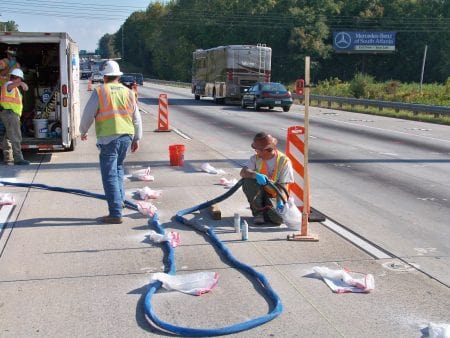Using Polyurethane Foam for Infrastructure and Industrial Applications
Most polyurethane foam concrete lifting jobs are residential or commercial. However, the foam has applications that stretch more into the infrastructure and industrial areas as well.
Some involve larger-scale applications of concrete lifting or void-filling. In other cases, they involve specialty polyurethane foam applications.
Lifting and Undersealing Streets with Polyurethane Foam

There are multiple ways in which you can use PolyPier polyurethane foam for road or highway projects.
The first group mimics how you would use polyurethane foam on other concrete slabs like sidewalks but simply on a larger scale.
If a portion of a road is sinking or if there is a known underground void that could cause problems for the road, polyurethane foam can be injected to level the roadway and fill the subsurface voids.
The second application is using polyurethane foam as an undersealing agent. In this case, the foam acts as a barrier, preventing water absorbed into the more permeable pavement surface from reaching the base layer, where it could cause damage.
PolyPier offers several different foams suitable for roadway applications. Read more about them here.
Airport Runways
Among the concrete slabs having to withstand the heaviest traffic are airport runways. Sinking slabs and cracking concrete can be a problem, especially if they reach the level where portions of the runway need to be redone, taking it out of service during the construction and curing process.
Polyurethane foam provides a solution with several key advantages. First, if done by a trained contractor it can be both precise and long-lasting. Second, it has a short application process and cures quickly, reducing the downtime for the runway while solving the sinking slab problem.
Abandoned Tank and Pipe Filling
When an underground tank or pipe are taken out of service, the best option is to remove them entirely from the ground.
Sometimes, however, this is either impossible or not cost effective. Filling the tank or pipe with an inert material is still necessary, however, to avoid collapse or other issues. Foam is a great solution to this problem.
Unlike some of the other options, the foam requires a small opening to be sprayed into the tank or pipe. It is also lightweight. This reduces the headaches if you must eventually remove the tank.
See the types of PolyPier suitable for tank filling applications.
Trench Breakers
Trench breaks are often installed at given during pipeline construction in order to inhibit the flow of water, prevent erosion and prevent the trench from collapsing.
Stacks of sandbags were once the method of choice. Now polyurethane foam is instead used. This method is both more efficient and more versatile than sandbags, easily adapting to almost any trench size.
Learn More About the Uses of PolyPier
If you want to learn more about the varied ways in which your business can use the various polyurethane foams sold by PolyPier, contact us today.